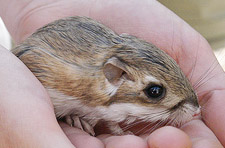
This week’s cute endangered animal is the kangaroo rat. Now you might not think that any animal with “rat” in its name would be cute, or in danger of disappearing, but both are true for several species of kangaroo rats here in the U.S. Despite its name, the kangaroo rat is not actually a rat, but rather a relation the gopher family. Currently, six species of kangaroo rats (genus Dipodomys) are facing extinction. They all live in the Western half of the US, starting in the Dakotas and extending West to California and Nevada, preferring desert habitats. The tiny animals measure just 2″ at the shoulder, and like to get around by hopping like kangaroos (as much as 6″ a leap!). Kangaroo rats are known for their love of dust baths, for cramming an incredible amount of food into their cheek pouches and, on occassion, for hiding under the crotches of hapless biologists.
The native kangaroo rat was thriving until the 1950s, when a two-tiered threat of agriculture and human development hit them: the farmers carried out pest-control campaigns against the rats (who found newly-tilled soil perfect for burrows), and new roads made it hard for rats to find new habitat. More recently, oil and natural gas exploration has been painted as a possible culprit in a number of rat deaths. Also, given that the rats relate their mating status and territory by thumping their long hind legs on the ground, one can only imagine that development also hinders intra-species communication.
The kangaroo rats’ survival is important to environmentalists because the animals are a “keystone species” in their environments. With kidneys four times as strong as humans’, kangaroo rats get most of their daily moisture from their food: seeds and nuts. By eating plants with the largest seeds, they allow plants with smaller seeds to flourish, which in turn effects the surrounding insect and bird populations.
Despite their importance to the ecosystem, the federal government has not been pro-active in protecting the kangaroo rat. Just last year, US Fish & Wildlife proposed cutting a California kangaroo rat’s protected habitat by about 2/3. Conservation groups said they were going to sue the department, and Fish & Wildlife relented by changing the planned habitat reduction. Scientists said last year that they will use an Israeli satellite to take pictures of the rats habitat which will help them get an accurate population count. Though just how accurate the satellites will be remains unknown. “It’s fairly rare for something so small to be a keystone species,” UC Berkeley’s Tim Bean told USA Today. “It’s easier to track, say, bison.”
















